Cardamom, Ceylon cardamom
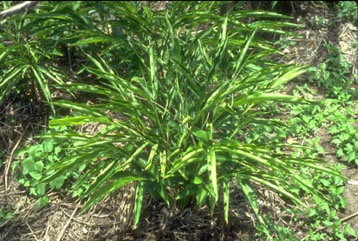
It is a tropical plant. It grows from sea level up to about 1,800 m altitude in the tropics. In PNG it is mostly between 550-1,700 m above sea level. It prefers warm, rich, moist soils. It needs a protected and partly shaded position. It is drought and frost tender. Seed need a temperature between 19 and 24°C to grow. Plants need a temperature above 10°C. It suits hardiness zones 10-12.
Also known as:
Bai dou kou, Buah pelaga, Cardamone, Choti-elachi, Ela, Elach, Elaichi, Elchi, Ella-kai, Enasal, Ensal, Hai, Ilaayaci, Illaichi, Kapulaga, Karadamungu, Kardemon, Krakao sbat, Kravan, Luk grawan, Luk kravan, Pai-tou-k'ou, Periyayalum, Phalazee, Phalar-phyu, Phalar-yaing, Upakunchika, Veldode, Xiao dou kou, Yelak-kayalu, Yelakkai, Yelakki, Yelam
Synonyms
- Alpinia cardamomum (L.) Roxb.
- Amomum cardamomum L.
- Amomum ensal Raeusch.
- Amomum racemosum Lam.
- Amomum repens Sonn.
- Amomum uncinatum Stokes
- Cardamomum malabaricum Pritz.
- Cardamomum minus (Gaertn.) Puntze
- Cardamomum officinale Salisb.
- Cardamomum verum Oken
- Elletaria cardamomum var. minus Watt
- Elettaria cardamomum var. minuscula Burkill
- Matonia cardamomum (L.) Stephenson & J. M. Churchill
- Zingiber minus Gaertn.
Edible Portion
- Fruit, Herb, Spice, Seeds, Leaves
Where does Cardamom grow?
Found in: Africa, Asia, Australia, Bangladesh, Bougainville, Cambodia, Central America, China, Costa Rica, Cuba, East Africa, East Timor, Fiji, Ghana, Guatemala, Hawaii, India, Indochina, Indonesia, Laos, Madagascar, Malawi, Malaysia, Maldives, Mexico, Myanmar, Nepal, North America, Pacific, Papua New Guinea, PNG, Philippines, SE Asia, Solomon Islands, Sri Lanka, Tanzania, Thailand, Timor-Leste, United States, Vietnam, West Africa
Notes: There are 7 Elettaria species.
Status: It is being grown commercially in some lowland areas of Papua New Guinea.
Growing Cardamom, Ceylon cardamom
Cultivation: Plants can be grown from seed. It is normally grown under the shade of the primary rainforest. Seeds are slow to germinate. It can be grown from slips of plants.
Edible Uses: The seeds are used as a flavouring. They are used in biscuits and cakes. It is also used in curries and added to coffee. The seeds are chewed after meals to sweeten the breath. The young shoots are eaten raw or steamed or roasted. Leaves are used for wrapping foods before cooking. The seeds are used in cakes.
Production: The capsules are harvested when they are almost ripe but before they turn yellow. They are then dried in a warmed and ventilated shed.
Nutrition Info
per 100g edible portion| Edible Part | Energy (kcal) | Protein (g) | Iron (mg) | Vitamin A (ug) | Vitamin c (mg) | Zinc (mg) | % Water |
|---|---|---|---|---|---|---|---|
| Seed | 312 | 10.8 | 14 | 0 | 21 | 7.5 | 8.3 |
Cardamom, Ceylon cardamom Photos

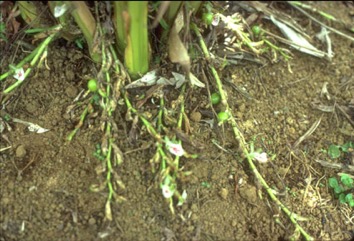
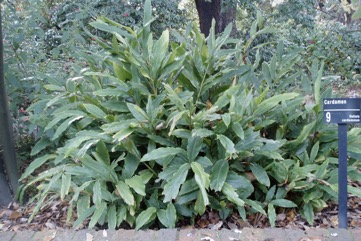
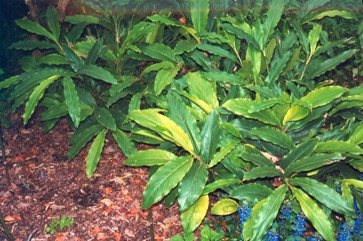
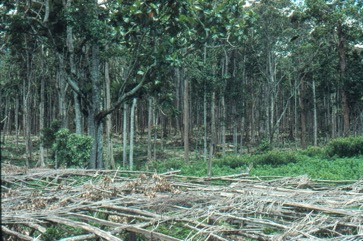
References
Ambasta, S.P. (Ed.), 2000, The Useful Plants of India. CSIR India. p 193
Bodkin, F., 1991, Encyclopedia Botanica. Cornstalk publishing, p 378
Bremness, L., 1994, Herbs. Collins Eyewitness Handbooks. Harper Collins. p 169
Brickell, C. (Ed.), 1999, The Royal Horticultural Society A-Z Encyclopedia of Garden Plants. Convent Garden Books. p 393
Brouk, B., 1975, Plants Consumed by Man. Academic Press, London. p 289
Brown, D., 2002, The Royal Horticultural Society encyclopedia of Herbs and their uses. DK Books. p 200
Burkill, I.H., 1966, A Dictionary of the Economic Products of the Malay Peninsula. Ministry of Agriculture and Cooperatives, Kuala Lumpur, Malaysia. Vol 1 (A-H) p 925
Cobley, L.S. (rev. Steele, W.M.) 2nd Ed., 1976, An Introduction to the Botany of Tropical Crops. Longmans. p 233
Cundall, P., (ed.), 2004, Gardening Australia: flora: the gardener's bible. ABC Books. p 534
Esperanca, M. J., 1988. Surviving in the wild. A glance at the wild plants and their uses. Vol. 1. p 189
Facciola, S., 1998, Cornucopia 2: a Source Book of Edible Plants. Kampong Publications, p 248, p 247 (As Amomum compactum)
Flowerdew, B., 2000, Complete Fruit Book. Kyle Cathie Ltd., London. p 163
French, B.R., 1986, Food Plants of Papua New Guinea, A Compendium. Asia Pacific Science Foundation p 344
French, B.R., 2010, Food Plants of Solomon Islands. A Compendium. Food Plants International Inc. p 326
Hedrick, U.P., 1919, (Ed.), Sturtevant's edible plants of the world. p 287
Hemphill, I, 2002, Spice Notes. Macmillan. p 104
Heywood, V.H., Brummitt, R.K., Culham, A., and Seberg, O., 2007, Flowering Plant Families of the World. Royal Botanical Gardens, Kew. p 409
Hibbert, M., 2002, The Aussie Plant Finder 2002, Florilegium. p 27 (As Amomum cardamomum)
Hutton, W., 1997, Tropical Herbs and Spices of Indonesia. Periplus. p 17
Hu, Shiu-ying, 2005, Food Plants of China. The Chinese University Press. p 325 (As Amomum cardamomum) (Also as Amomum cardamomum)
Kiple, K.F. & Ornelas, K.C., (eds), 2000, The Cambridge World History of Food. CUP p 432, 1745 (Also as Amomum cardamomum)
Kybal, J., 1980, Herbs and Spices, A Hamlyn Colour Guide, Hamlyn Sydney p 92
Macmillan, H.F. (Revised Barlow, H.S., et al), 1991, Tropical Planting and Gardening. Sixth edition. Malayan Nature Society. Kuala Lumpur. p 374
Martin, F.W. & Ruberte, R.M., 1979, Edible Leaves of the Tropics. Antillian College Press, Mayaguez, Puerto Rico. p 225 (As Amomum cardamomum)
Menninger, E.A., 1977, Edible Nuts of the World. Horticultural Books. Florida p 81
Miguel, E., et al, 1989, A checklist of the cultivated plants of Cuba. Kulturpflanze 37. 1989, 211-357
Morton, (As Amomum cardamomum)
Mulherin, J., 1994, Spices and natural flavourings. Tiger Books, London. p 31
Ochse, J. J. et al, 1931, Vegetables of the Dutch East Indies. Asher reprint. p 732 (As Amomum cardamomum)
Phon, P., 2000, Plants used in Cambodia. © Pauline Dy Phon, Phnom Penh, Cambodia. p 272
Purseglove, J.W., 1972, Tropical Crops. Monocotyledons. Longmans p 528
Raghavan, S., 2007, Handbook of Spices, Seasonings, and Flavourings. Second Edition. CRC Press p 80
Rajapaksha, U., 1998, Traditional Food Plants in Sri Lanka. HARTI, Sri Lanka. p 509
Seidemann J., 2005, World Spice Plants. Economic Usage, Botany, Taxonomy. Springer. p 144
Small, E., 2009, Top 100 Food Plants. The world's most important culinary crops. NRC Research Press. p 153
Smith, A.C., 1979, Flora Vitiensis Nova, Lawaii, Kuai, Hawaii, Volume 1 p 202
Smith, P.M., 1979, Cardamoms, in Simmonds, N.W., (ed), Crop Plant Evolution. Longmans. London. p 324
Solomon, C., 2001, Encyclopedia of Asian Food. New Holland. p 65
Sp. pl. 1:1. 1753 (As Amomum cardamomum)
Staples, G.W. and Herbst, D.R., 2005, A tropical Garden Flora. Bishop Museum Press, Honolulu, Hawaii. p 769
Sukarya, D. G., (Ed.) 2013, 3,500 Plant Species of the Botanic Gardens of Indonesia. LIPI p 1105
Terra, G.J.A., 1973, Tropical Vegetables. Communication 54e Royal Tropical Institute, Amsterdam, p 23 (As Amomum cardamomum)
Trans. Linn. Soc. London 10:254, t. 5. 1811
Tyagi, R. K., et al, 2004, Conservation of Spices Germplasm in India. Indian J. Plant Genet. Resour. 17(3): 163-174
Uphof, (As Amomum cardamomum)
van Wyk, B., 2005, Food Plants of the World. An illustrated guide. Timber press. p 186
Vickery, M.L. and Vickery, B., 1979, Plant Products of Tropical Africa, Macmillan. p 87
Williams, C.N., Chew, W.Y., and Rajaratnam, J.A., 1989, Tree and Field Crops of the Wetter Regions of the Tropics. Longman, p 223
Woodward, P., 2000, Asian Herbs and Vegetables. Hyland House. p 69
World Checklist of Useful Plant Species 2020. Royal Botanic Gardens, Kew